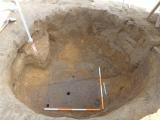

Facebook Twitter Flickr YouTube RSS Feed
Written on: September 17th, 2012 in Archaeology Updates, US301
Well, well, well… At the Cardon Holton site we almost made it to the bottom of the well using conventional hand excavation but with two feet left to go the side walls from the original cone of excavation started to fissure and made further investigations unsafe. With assistance from the backhoe we were able to retrieve the four corner posts and the plank sidewalls. The posts were hand-hewn with an adze and the ends pointed with an axe. Two of the longer posts exhibited a drilled hole about 5 feet up from the base and one retains bark, which should provide a good candidate for dendrochronology. No signs of cross members were visible suggesting perhaps the holes were used to lower the partially constructed box into the hole. The sides were fashioned from large logs, split with a froe forming wedge-shaped planks (some also with bark). The planks were pinned onto the corner posts with small wrought nails and held into position by a layer of clay and the pressure of the surrounding soil. All of the wooden remains were washed and observations were recorded before wrapping the saturated specimens in clear plastic wrap and then stored under a dark tarp to retard fungal growth. Excavation of the main root cellar recovered several straight pins, egg shell, fish scales, small lead shot and bits of gunflints.
Written on: September 17th, 2012 in Archaeology Updates, US301
Last week at the Cardon/Holton Site the Hunter Research Inc. crew worked hard removing the remainder of pits started last week. The pit with the juvenile articulated pig turned out to be more complicated than we first thought. The articulated bones only represented the limbs of one, possibly two pigs with the upper portion of a skull from a larger mature pig. These bones may represent pieces of meat from a feature thought to be a smokehouse. Why the limbs would remain articulated is a bit of a mystery we don’t have an answer for at this time. Another nearby pit exhibits reddened soils at the base resulting from fire (likely for cooking) as evidenced by fire-crack rock and chunks of charcoal. The pit was flanked by a pair of medium-sized posts which likely suspended a cooking vessel such as a cauldron. Several pieces of cast iron cauldrons were found in the vicinity during the Phase IB survey. Excavation in the shaft feature thought to be a well, have proven fruitful as the clear outline of a square four-foot wooden shaft has evolved. Artifacts recovered from the site thus far seem to indicate the site was abandoned by around 1740. Recent research indicates William Cardon passed away prior 1737. His son also William Cardon, a minor became a ward of Boaz Boyce who later ends up with the property. It also appears that the property is occupied for a short period by a tenant, Robert Whiteside in 1742. Hopefully additional research will provide insights and answers to the new questions generated by the archaeology.
